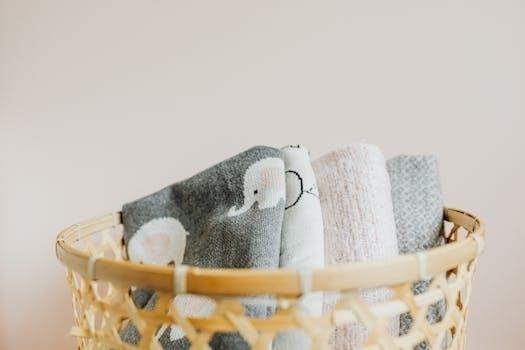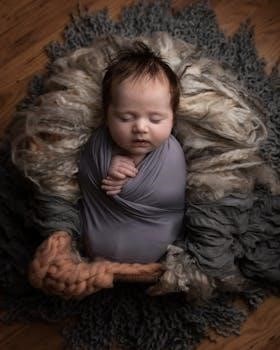No Sew Fleece Blanket Instructions PDF⁚ A Comprehensive Guide
Are you ready to embark on a cozy crafting adventure? This comprehensive guide provides step-by-step instructions for creating a beautiful no-sew fleece blanket! Download the FREE project instructions in PDF format to get started today. Learn how to make a warm and comforting blanket without any sewing skills required.
Materials Needed for a No Sew Fleece Blanket
To begin your no-sew fleece blanket project, gathering the right materials is essential. First, you’ll need two pieces of coordinating fleece fabric. The amount of fabric depends on the desired blanket size; for a baby blanket, 1 to 1 1/2 yards of each fabric is suitable. For a child’s blanket, consider purchasing 1 1/2 to 2 yards, and for an adult blanket, 2 yards or more may be necessary. Ensure the fleece is outerwear fleece for extra warmth.
Next, acquire a good pair of sharp scissors or a rotary cutter and mat for precise and easy cutting. A ruler or tape measure is needed to ensure straight lines and accurate measurements when cutting the fringe. Additionally, masking tape and chalk can be helpful for marking the cutting lines.
Optional materials include Jills Blankets labels for personalizing your creation and thread and a needle if you decide to add any hand-sewn details. With these supplies in hand, you’ll be well-prepared to create a cozy and personalized no-sew fleece blanket.
Selecting Fleece Fabric⁚ Types and Quantities
Choosing the right fleece fabric is crucial for a cozy and durable no-sew blanket. Anti-pill polar fleece is highly recommended due to its resistance to pilling, ensuring a smooth and soft texture even after washing. Other options include blizzard fleece or outerwear fleece, which offer excellent warmth and are readily available at local fabric stores like JoAnn Fabrics or Hobby Lobby, as well as online sources.
When selecting your fleece, consider pairing a print fabric with a coordinating solid color to add visual appeal. The quantity of fabric needed depends on the intended blanket size. For a baby blanket, 1 to 1.5 yards of each fabric is generally sufficient. A child-sized blanket typically requires 1.5 to 2 yards, while an adult-sized blanket may need 2 yards or more.
Remember to purchase enough fabric to allow for trimming and squaring off the edges. It’s always a good idea to have a little extra to accommodate any mistakes or design adjustments. With the right type and amount of fleece, your no-sew blanket will be both beautiful and functional.
Cutting the Fleece⁚ Preparing for Fringe
Once you have selected your fleece fabrics, the next step is to prepare them for creating the fringe. Begin by laying both pieces of fleece on a flat surface, wrong sides together, ensuring that the edges are aligned. Use sharp scissors or a rotary cutter and mat to trim the selvages, which are the finished edges of the fabric. The selvage often has a different texture or printed words, so it’s important to remove it to create a clean, straight edge.
Next, square off the ends of the fleece to ensure that the blanket is rectangular. This can be done using a ruler or square corner tracers to create precise lines. Once the edges are trimmed and squared, cut a 4-inch square from each corner of both layers of fleece. These cut-out corners will serve as a guide for creating the fringe.
To prepare for cutting the fringe, use masking tape or chalk to mark a line 4 inches from the edge of the fabric on all four sides. This line will indicate the length of the fringe and ensure that it is uniform around the entire blanket.
Creating the Fringe⁚ Measuring and Cutting Techniques
With the fleece prepared, it’s time to create the fringe that will give your no-sew blanket its distinctive look. Using a ruler or measuring tape, mark 1-inch wide strips along all four sides of the fleece, up to the 4-inch line you previously marked. These marks will guide your cuts and ensure that the fringe is uniform in width.
Using sharp scissors, cut along the marked lines, cutting through both layers of fleece at the same time. It’s important to make clean, straight cuts to create a neat and professional-looking fringe. Ensure that each cut extends from the edge of the fabric up to the 4-inch line, creating individual fringe pieces.
For a more precise and efficient cutting process, consider using a rotary cutter and mat. This will allow you to make multiple cuts at once, saving time and ensuring consistency. If you are working with a large group, it’s helpful to have several pairs of scissors available to speed up the process. Remember, the fringe pieces should be a little wider than the width of your finger for the best results.
Tying the Fringe⁚ Different Methods and Tips
Once the fringe is cut, the next step is tying the fringe to secure the two layers of fleece together. The most common method involves tying the corresponding fringe pieces from the top and bottom layers together in a simple overhand knot. Take one fringe piece from the top layer and one from the bottom layer, and tie them together close to the base of the fringe.
Ensure that the knots are secure but not too tight, as this can cause the blanket to pucker. Avoid tying the fringe too tightly or at the very base, as this can also distort the shape of the blanket. An alternative method involves looping the fringe through, creating a knot by pushing upwards.
There are also variations where you can braid or twist the fringe before tying, adding a decorative touch. To maintain consistency, tie all the knots in the same direction and with the same tension. As you tie, ensure the edges of the fleece remain aligned. If you find the edges slipping, use masking tape to hold them in place. For a neat finish, trim any uneven fringe ends after tying.

Braided Edge Option⁚ An Alternative to Tying
For those seeking a different aesthetic or a more secure edge, a braided edge offers a stylish alternative to the traditional tied fringe. This method involves creating a continuous braid around the blanket’s perimeter using the fleece fringe. Start by dividing the fringe into sections of three strands each.

Take the right strand and cross it over the middle strand, then take the left strand and cross it over the new middle strand. Continue this braiding pattern, working your way around the entire blanket. As you braid, ensure the braid is snug but not too tight to prevent puckering.
When you reach a corner, simply continue the braiding pattern, maintaining a consistent tension. Once you’ve braided all the way around, secure the end of the braid by tucking it into the adjacent braid or using a small amount of fabric glue. This braided edge provides a durable and visually appealing finish, adding a unique touch to your no-sew fleece blanket.
Experiment with different braiding styles, such as a fishtail braid, to further customize your blanket’s edge. A braided edge creates a polished look.
Size Considerations⁚ Baby, Child, and Adult Blankets

When crafting a no-sew fleece blanket, choosing the appropriate size is crucial for optimal comfort and functionality. For baby blankets, a common size is approximately 30×36 inches, providing a cozy wrap without being overly large. This size is perfect for swaddling or draping over a stroller.
Child-sized blankets typically range from 45×60 inches to 50×60 inches, offering ample coverage for a growing child to snuggle with during nap time or while watching television. These dimensions ensure the blanket is large enough to provide warmth and comfort without being too cumbersome.

Adult blankets come in various sizes, with common dimensions including 60×72 inches for a throw blanket and 72×90 inches or larger for a twin or full-sized blanket. Consider the recipient’s height and preferred use when selecting the size for an adult blanket. A larger blanket provides more coverage and warmth, while a smaller throw blanket is ideal for draping over a couch or armchair.
Remember to adjust the fleece fabric quantities accordingly based on your chosen blanket size. Always measure twice and cut once to ensure accurate dimensions.
Customization⁚ Color Combinations and Personal Touches
Unleash your creativity and personalize your no-sew fleece blanket with unique color combinations and personal touches! Choosing coordinating fleece fabrics in complementary colors or contrasting patterns can transform a simple blanket into a stylish statement piece. Consider selecting colors that reflect the recipient’s favorite hues or complement their home décor.
Adding personal touches can make your blanket even more special. Monogramming the blanket with the recipient’s initials or a meaningful symbol using fabric markers or embroidery is a thoughtful gesture. Appliqués, such as felt shapes or fabric scraps, can be sewn or glued onto the fleece for a whimsical design;
Experiment with different fringe styles to add visual interest. Varying the length or thickness of the fringe, or incorporating braided elements, can create a unique border. Consider adding embellishments like pom-poms, tassels, or beads to the fringe for a playful touch.
Remember to consider the recipient’s preferences and personality when customizing your blanket. A personalized no-sew fleece blanket is a heartfelt gift that will be treasured for years to come.
Care Instructions⁚ Washing and Maintaining Your Fleece Blanket
To ensure your no-sew fleece blanket remains soft, cozy, and vibrant for years to come, proper care and maintenance are essential. Fleece is generally easy to care for, but following these guidelines will help prolong its lifespan and prevent damage.
Before washing, check the manufacturer’s label for specific care instructions. In most cases, machine washing on a gentle cycle with cold water is recommended. Use a mild detergent that is safe for delicate fabrics. Avoid using bleach or fabric softeners, as they can damage the fleece fibers and reduce their softness.
Tumble dry on low heat or, preferably, air dry to prevent shrinkage and maintain the blanket’s shape. Avoid using high heat, as it can melt the fleece fibers. If you choose to machine dry, remove the blanket promptly once it’s dry to prevent wrinkles.
To prevent pilling, wash the blanket inside out. If pilling does occur, use a fabric shaver to gently remove the pills. Store the blanket in a cool, dry place away from direct sunlight to prevent fading. With proper care, your no-sew fleece blanket will provide warmth and comfort for years to come.
